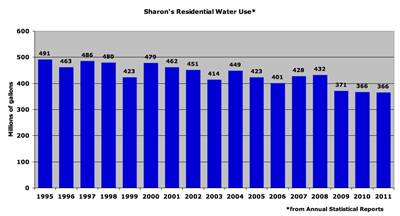Sharon’s Conservation-Oriented Water Rates
For over 20 years, Sharon has had ascending block water rates that increase as usage increases.
 Water rates are also higher in summer, when water is scarcest.
Water rates are also higher in summer, when water is scarcest.
Sharon’s rate structure is designed to encourage water conservation, and it has served the town well. Residential water use has declined by roughly 100 million gallons per year, even as population has increased by approximately 7 percent since 1995.
Sharon is saving about $70,000 per year in the combined cost of energy to pump the town’s six wells plus the cost of chemicals to treat the water. Further, water conservation has helped the town avoid the $3 million cost of a water filtration plant, the $6 million cost of a High Pressure Service District, and the $6 million cost of connecting to MWRA (Massachusetts Water Resources Authority) for supplementary water plus the high cost of the MWRA water itself.
Average per-capita water use varies dramatically from household to household. Some households average 25 gallons per person per day or less, while others use well over 100 gallons per person per day. Those who use large amounts of water for nonessential purposes like lawn irrigation drive up the cost of water for everyone, compromise water quality, and impact local streams and wetlands, so it is appropriate that they should pay at a higher rate.
Single-rate system would cut the cost of water for lawn irrigation in half
 Some members of the Water Management Advisory Committee have proposed scrapping Sharon’s conservation-oriented water rates in favor of a single rate of $6.50 per thousand gallons. They also want to increase the fixed account fee from $15 per quarter to $30 per quarter. This proposal would effectively cut the cost of water used for lawn irrigation in half while increasing the cost of water for conserving households and reducing the incentive to conserve.
Some members of the Water Management Advisory Committee have proposed scrapping Sharon’s conservation-oriented water rates in favor of a single rate of $6.50 per thousand gallons. They also want to increase the fixed account fee from $15 per quarter to $30 per quarter. This proposal would effectively cut the cost of water used for lawn irrigation in half while increasing the cost of water for conserving households and reducing the incentive to conserve.
The proponents of a single rate say that ascending block water rates are unfair to large families, since it is harder for large families to keep their water use within the lowest rate block. While there is truth to this claim, there are several countering factors:
- Large families tend to use less water per person due to efficiencies of scale. For example, in Sharon the median family of six uses 37 gallons per person per day, whereas the median family of two uses 62 gallons per person per day. Note that conserving families of all sizes would pay higher water bills with a single rate and a higher fixed account fee, to make up for lower water bills of heavy users.
- Large families that conserve currently pay modest water bills and have ample opportunity to lower them. A family of six that averages 37 gallons per person per day would pay only $1.48 per day for water. A family of six that averages 25 gallons per person per day would pay only 89¢ per for 150 gallons of water delivered daily to the tap, less than half the $2.00 cost of a 20-oz. bottle of Dasani bottled water at the Sharon train station vending machine.
- Large families that send their kids to Sharon public schools are heavily subsidized by the majority of households that do not have school-age children—a subsidy that dwarfs the small extra cost of water that large families who conserve pay with conservation-oriented water rates.
Sharon’s leaders are actively courting developers to build malls and senior living facilities in Sharon in an effort to augment tax revenues, but new development will require water. If we continue to improve our water use efficiency, we can accommodate new development without the multimillion dollar cost of importing supplementary water from MWRA.
Conservation-oriented water rates address environmental impacts
Water rates are designed to generate enough revenue to pay the cost to operate the Water Department and maintain water supply infrastructure. However, nobody has to write a check to pay for the environmental damage caused by withdrawing half a billion gallons per year from Sharon’s aquifers.
The only way water rates address this hidden environmental cost is by providing a strong incentive to conserve water through the steeply ascending block rate structure and summer rate premium. The proposed single-rate structure and higher fixed account fee would greatly diminish the incentive to conserve.
Sharon’s success with water conservation is a model for other communities. It is exactly the kind of improvement we need in order to create a more hopeful future for our children and grandchildren. However, we still have a long way to go. We should not stall our progress by scrapping the conservation-oriented water rates that are driving improved water use efficiency in Sharon.
Please support Sharon’s conservation water rates by signing the petition athttp://www.ipetitions.com/petition/keep-conservation-water-rates/.
